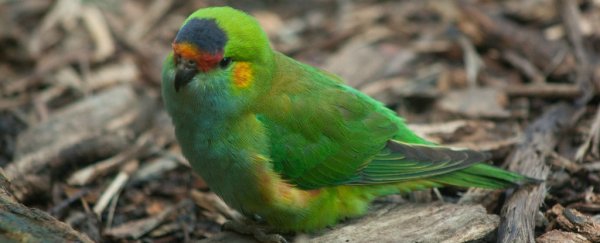Despite several warnings and some major red flags, the Australian government has allowed hundreds of rare and endangered birds to be sent to a zoo in Germany.
The only problem is, some are not convinced that the destination is a real, legitimate zoo - at least, not one that the public can actually visit - and they are worried the precious birds have been sold off rather than exhibited.
An exclusive report from The Guardian Australia has now laid out the full controversy.
Under Australian law, it is currently illegal to export a native species for commercial purposes. The only exception is if the species is sent to a registered zoo for conservation, research, or display.
So in 2015, Australia granted a display permit to a Berlin-based non-profit called the Association for the Conservation of Threatened Parrots (ACTP).
The contract was simple: ACTP could take native birds from Australia and export them back to their certified zoos in Germany for display purposes only. Under absolutely no circumstances was the organisation allowed to sell the birds or their offspring.
Since then, according to The Guardian, ACTP has exported 232 native birds from Australia - more than 80 percent of all the live native birds legally exported from Australia in the same period.
The precious cargo, including 16 glossy black cockatoos (Calyptorhynchus lathami) and 26 purple-crowned lorikeets (Glossopsitta porphyrocephala), was worth hundreds of thousands of dollars.
But while ACTP may have assured Australia that it had multiple facilities to display these precious creatures, none of these are freely open to the public. And although it is registered as a zoo in Germany, it is not registered with any major international zoological association.
"Its main premises at Tasdorf, a village 30 km [18.6 miles] outside Berlin, displays no public information other than a mobile phone number," Lisa Cox and Philip Oltermann report in The Guardian.
"Its location is not advertised and the buildings display no opening hours nor any other indication that the public is welcome to visit."
So what is happening to these birds if they aren't being displayed in a public zoo?
The truth is, it's not really clear what the non-profit even does, despite the fact that it is now home to the largest private collections of threatened birds in the world, imported from Saint Lucia, Saint Vincent, Dominica, Brazil and Australia.
And, according to The Guardian, there have been some reports of native Australian birds being sold in Europe, which could be the offspring of the birds sent to ACTP.
It doesn't look good. Especially given the fact that previous to the ACTP export, glossy black cockatoos had never before left the great south land, and only four other purple-crowned lorikeets have ever been legally exported from Australia.
The sad part is, Australia could have avoided all of this. The government was repeatedly warned of concerns from international wildlife authorities, private breeders, international conservation bodies and scientists.
"I think there needs to be a full investigation as to the reasons why, in spite of warnings going back over 12 months – not only from me but from others within the industry – that concerns have been ignored," Australian federal MP Warren Entsch told The Guardian.
The environment department, however, is pointing the blame elsewhere. A spokesperson said her department is only responsible for looking into the backgrounds of those exporting birds and not the importers.
You can read more about the investigation over at The Guardian.
